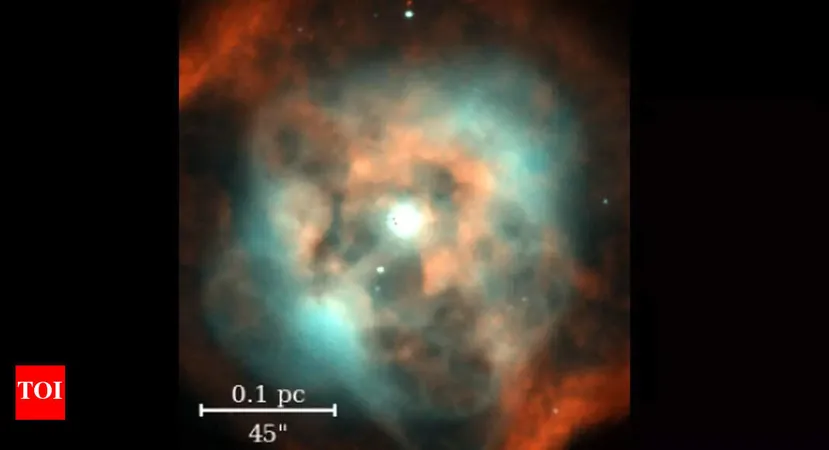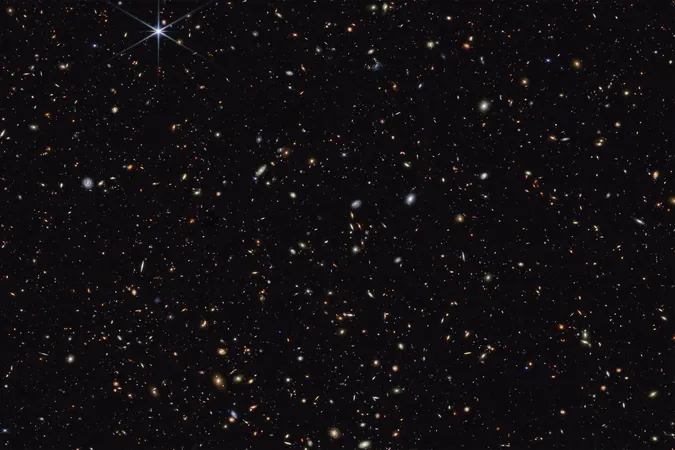
Unveiled Mysteries: James Webb’s Stunning Discovery of Ghostly Rings Around a Dying Star
2025-09-04
Author: Ming
A Cosmic Revelation by JWST
The James Webb Space Telescope (JWST) has captured breathtaking images of the planetary nebula NGC 1514, unveiling ethereal infrared-bright rings surrounding a dying binary star system located about 1,500 light-years from Earth. These remarkable observations, obtained using the Mid-Infrared Instrument (MIRI), allow scientists to delve into the complex history—a staggering 4,000 years—of this stellar remnant.
The Past Revisited: NGC 1514's Fascinating History
First discovered by astronomer William Herschel in 1790, NGC 1514 has evolved from a simple hazy glow to a rich tapestry of cosmic phenomena. Herschel’s initial observations laid the groundwork for a deeper understanding of nebulae, challenging the conventional wisdom of his time. NASA’s Wide-field Infrared Survey Explorer (WISE) in 2010 hinted at the existence of infrared rings, but the exact nature of these structures remained elusive—until now, thanks to JWST.
The Enigmatic Core: A Binary Dance
At the heart of this nebula lies a fascinating binary star system: a white dwarf and its giant companion. As the dying star shed its outer layers, it transformed into a white dwarf, creating the luminous nebula we see today. The close orbit of its companion has produced a striking hourglass shape, evident in JWST’s stunning imagery. These rings exhibit asymmetries and peculiar dust patterns, suggesting intense gravitational interactions that continue to baffle astronomers.
Surprising Emission Signatures in the Rings
One of JWST’s most intriguing findings is the type of emission from the rings. Unlike many other planetary nebulae that release signals from molecules like polycyclic aromatic hydrocarbons, a staggering 98% of the light from NGC 1514’s rings stems from thermal radiation emitted by cool dust grains. This revelation hints at the rings’ fragility and unique structure, leaving many questions about their formation unanswered.
Transformative Insights into Stellar Evolution
From mysterious beginnings, NGC 1514 has transformed into a key to unlocking the secrets of stellar death. The nebula’s ghostly rings challenge our established theories on stellar evolution and illuminate the intricate dynamics of binary star systems. These awe-inspiring observations underscore JWST’s pivotal role in enhancing our comprehension of planetary nebulae and the ever-evolving cosmos.
As researchers continue to unravel the mysteries of NGC 1514, they are not just learning about this dying star but are also redefining our understanding of the universe's lifecycle.



 Brasil (PT)
Brasil (PT)
 Canada (EN)
Canada (EN)
 Chile (ES)
Chile (ES)
 Česko (CS)
Česko (CS)
 대한민국 (KO)
대한민국 (KO)
 España (ES)
España (ES)
 France (FR)
France (FR)
 Hong Kong (EN)
Hong Kong (EN)
 Italia (IT)
Italia (IT)
 日本 (JA)
日本 (JA)
 Magyarország (HU)
Magyarország (HU)
 Norge (NO)
Norge (NO)
 Polska (PL)
Polska (PL)
 Schweiz (DE)
Schweiz (DE)
 Singapore (EN)
Singapore (EN)
 Sverige (SV)
Sverige (SV)
 Suomi (FI)
Suomi (FI)
 Türkiye (TR)
Türkiye (TR)
 الإمارات العربية المتحدة (AR)
الإمارات العربية المتحدة (AR)